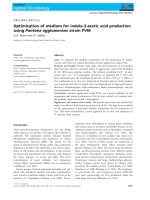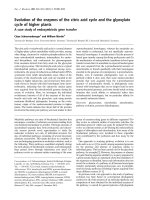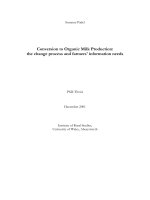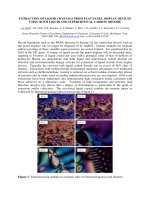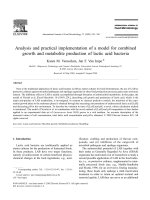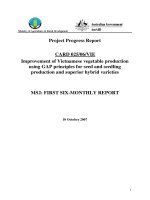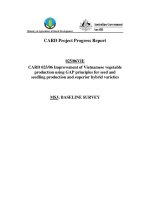Soft cheese production using citric acid and rennet as coagulants
Bạn đang xem bản rút gọn của tài liệu. Xem và tải ngay bản đầy đủ của tài liệu tại đây (7.07 MB, 146 trang )
MINISTRY OF EDUCATION AND TRAINING
HO CHI MINH CITY UNIVERSITY OF TECHNOLOGY AND EDUCATION
FACULTY FOR HIGH QUALITY TRAINING
CAPSTONE PROJECT
FOOD TECHNOLOGY
SOFT CHEESE PRODUCTION USING CITRIC ACID
AND RENNET AS COAGULANTS
LECTURER: PhD. PHAM THI HOAN
STUDENT: PHAN NGUYEN NGOC KHANH
LE THI NGOC YEN
SKL 0 0 8 4 4 3
Ho Chi Minh City, December, 2021
HO CHI MINH UNIVERSITY OF TECHNOLOGY AND EDUCATION
FACULTY OF HIGH QUALITY TRAINING
GRADUATION THESIS
CODE: 2021-17116013
SOFT CHEESE PRODUCTION USING
CITRIC ACID AND RENNET AS COAGULANTS
Advisor: PhD. PHAM THI HOAN
Student: PHAN NGUYEN NGOC KHANH
LE THI NGOC YEN
HO CHI MINH CITY - 12/2021
i
Student ID: 17116013
17116045
ii
ACKNOWLEDGEMENTS
Firstly, we would like to express our heartfelt gratitude to all of the lectures at Ho
Chi Minh City University of Technology and Education in general and lecturers at the
Faculty of Chemical and Food Technology especially. We gained valuable knowledge and
skills regarding Food Technology throughout our four years at the school.
We would like to express our appreciation to PhD. Pham Thi Hoan - lecturer at the
Department of Food Technology, Faculty of Chemical and Food Technology, Ho Chi Minh
City University of Technology and Education. She was always enthusiastic in her support
and teaching us, mentoring and imparting knowledge and experiences from the idea to the
completed graduation thesis. We are truly grateful for that, and we will keep her teaching in
mind.
We would like to show our thanks to Ms Ho Thi Thu Trang, consultant in charge of
the Department of Food Technology laboratories and workshops. She had been supportive
and helpful with tools, machinery and equipment during our experimental research process.
We also would like to express our deep sense of gratitude to the instructors in charge of Food
Technology workshop 1, workshop 3, Microbiology laboratory, Biochemistry laboratory
and Sensory laboratory who created an ideal environment for us to complete this project.
We are very grateful to everyone who made my experience at Ho Chi Minh
University of Technology and Education very positive and enjoyable; this experience would
not have been possible without my friends, family, fellow students and mentors. This project
has been one of the most challenging things we have done, but also one of the most enjoyable
and rewarding. It is impossible to prevent faults while implementing the thesis, so we look
forward to hearing your feedback on our thesis. Once again, we gratefully acknowledge you
and wish you all the best.
Best regards!
iii
iv
v
vi
vii
viii
ix
x
xi
xii
xiii
xiv
xv
TABLE OF CONTENT
GRADUATION PROJECT ASSIGNMENT ...................... Error! Bookmark not defined.
ACKNOWLEDGEMENTS .................................................................................................. iii
DISCLAIMER ...................................................................................................................... iv
TABLE OF CONTENT ......................................................................................................... v
LIST OF ACRONYMS ...................................................................................................... xix
LIST OF FIGURES ............................................................................................................. xx
LIST OF TABLES .............................................................................................................. xxi
ABSTRACT....................................................................................................................... xxii
CHAPTER 1: INTRODUCTION .......................................................................................... 1
1.1. The study scientific imperative .................................................................................. 1
1.2. Objectives and tasks of the study ............................................................................... 2
1.2.1. Study objectives .................................................................................................. 2
1.2.2. Study tasks .......................................................................................................... 2
1.3. Research methodology ............................................................................................... 3
1.4. Study contribution ...................................................................................................... 3
1.4.1. Scientific potential .............................................................................................. 3
1.4.2. Practice potential ................................................................................................. 3
1.5. Study structure ............................................................................................................ 3
CHAPTER 2: LITERATURE REVIEW ............................................................................... 4
2.1. Cheese and soft cheese overview ............................................................................... 4
2.1.1. General introduction............................................................................................ 4
2.1.2. Soft cheese classification .................................................................................... 5
2.1.3. Chemical compositions of some soft cheese varieties ........................................ 6
2.1.4. Soft cheese procedure ......................................................................................... 7
2.1.5. Cheese production and consumption in Vietnam................................................ 9
2.2. Ingredients of cheese manufacturing ........................................................................ 12
2.2.1. Fresh milk.......................................................................................................... 12
2.2.2. Skim milk powder ............................................................................................. 13
2.3. Casein coagulated mechanism .................................................................................. 15
xvi
2.3.1. Milk protein ....................................................................................................... 15
2.3.2. Casein coagulation types in soft cheese manufacturing .................................... 17
2.4. Citric acid ................................................................................................................. 19
2.4.1. Citric acid .......................................................................................................... 19
2.4.2. Citric acid applications ...................................................................................... 19
2.5. Rennet ....................................................................................................................... 21
2.5.1. Rennet introduction ........................................................................................... 21
2.5.2. Types of rennet or coagulants ........................................................................... 21
2.6. Mechanism of gel formation during combined acidification and renneting ............ 23
2.6.1. Primary enzymatic phase .................................................................................. 23
2.6.2. Secondary (non – enzymatic phase) .................................................................. 24
2.7. Research situation ..................................................................................................... 24
2.7.1. Overseas researches .......................................................................................... 24
2.7.2. Domestic researches .......................................................................................... 26
CHAPTER 3: MATERIALS AND METHODS ................................................................. 27
3.1. Materials, chemicals and equipment ........................................................................ 27
3.1.1. Materials ........................................................................................................... 27
3.1.2. Chemicals .......................................................................................................... 28
3.1.3. Equipment ......................................................................................................... 28
3.2. Soft cheese manufacturing ....................................................................................... 30
3.3. Research plan............................................................................................................ 34
3.4. Experimental designs................................................................................................ 35
3.4.1. Experiment 1: The effect of citric acid concentration on protein coagulation .. 35
3.4.2. Experiment 2: The effect of incubation temperature on protein coagulation ... 36
3.4.3. Experiment 3: The effect of rennet concentration on protein coagulation........ 37
3.5. Analysis methods...................................................................................................... 38
3.5.1. Cheese yield ...................................................................................................... 38
3.5.2. Cheese solid yield ............................................................................................. 39
3.5.3. Syneresis ........................................................................................................... 39
3.5.4. Cheese acidity determination ............................................................................ 39
3.5.5. Texture analysis ................................................................................................ 40
xvii
3.5.6. Sensory evaluation ............................................................................................ 41
3.5.7. Microbiological analysis ................................................................................... 42
3.5.8. Color space measurement ................................................................................. 43
3.5.9. Scanning electron microscopy (SEM) method ................................................. 44
3.5.10. Determination of chemical compounds .......................................................... 44
3.5.11. Statistical analysis ........................................................................................... 44
CHAPTER 4: RESULTS AND DISCUSSION................................................................... 45
4.1. Milk powder’s chemical components ....................................................................... 45
4.2. The effect of citric acid and rennet on soft cheese quality ....................................... 45
4.2.1. The effect of pH renneting on soft cheese criteria ............................................ 45
4.2.2. The influence of incubation temperature on soft cheese criteria ...................... 48
4.2.3. The effect of rennet concentration of soft cheese criteria ................................. 50
4.3. Soft cheese technological process ............................................................................ 52
4.4. Soft cheese quality evaluation .................................................................................. 54
4.4.1. Chemical compositions of soft cheese .............................................................. 54
4.4.2. Microstructure observation of soft cheese ........................................................ 55
4.4.3. Sensory evaluation of soft cheese ..................................................................... 57
4.5. Evaluation the quality properties of soft cheese during the storage period .............. 59
4.5.1. Synereris ............................................................................................................ 61
4.5.2. Color .................................................................................................................. 63
4.5.3. Acidity ............................................................................................................... 64
4.5.4. Texture .............................................................................................................. 65
CHAPTER 5: CONCLUSION AND RECOMMENDATIONS ......................................... 67
5.1. Conclusion ................................................................................................................ 67
5.2. Recommendations .................................................................................................... 67
REFERENCES ...................................................................................................................... 1
APPENDICES ..................................................................................................................... 10
xviii
LIST OF ACRONYMS
CCP
Colloidal calcium phosphate
COA
Certificate of Analysis
CSY
Cheese solid yield
ISO
International Organization for Standardization
GMO
Genetically Modified Organisms
H
Cheese yield
TCVN
Vietnamese standard
TScheese
Total solid in cheese
TSwhey
Total solid in whey
xix
LIST OF FIGURES
Figure 2.1. Cottage cheese ..................................................................................................... 6
Figure 2.2. Quark cheese ....................................................................................................... 6
Figure 2.3. The general procedure of soft cheese .................................................................. 8
Figure 2.4. Cheese company share ...................................................................................... 10
Figure 2.5. Fresh/ soft cheese varieties classified through methods of coagulation ............ 17
Figure 2.6. Description of gel formation during combined acidification and renneting ..... 23
Figure 2.7. Summary of the rennet coagulation of milk. The primary phase involves
enzymatic hydrolysis of κ – casein, while the secondary phase involves aggregation
of the rennet- altered (para – casein) micelles into a three-dimensional gel network
(coagulum) .................................................................................................................. 24
Figure 3.1. The flowchart of soft cheese production coagulated by rennet and citric acid . 30
Figure 3.2. Schematic of cheese curd pressing apparatus.................................................... 32
Figure 3.3. The cylindrical draining mold (left) and the 1-kg cylindrical block ................. 33
Figure 3.4. Experiment 1 layout .......................................................................................... 35
Figure 3.5. Experiment 2 layout (A) and milk coagulation image (B) ................................ 37
Figure 3.6. Texture analysis layout of soft cheese samples ................................................. 41
Figure 3.7. Preparation of soft cheese sample for sensory evaluation ................................. 42
Figure 4.1. The effect of citric acid concentration on soft cheese quality criteria (A:
changes of cheese yield and TSwhey; B: changes of TS cheese and CSY) ............... 46
Figure 4.2. The influence of coagulation temperature on soft cheese criteria (A: changes of
cheese yield and TSwhey; B: changes of TScheese and CSY) ................................... 48
Figure 4.3. The flowchart of soft cheese production using acid and rennet as coagulants .. 53
Figure 4.4. Scanning electron microscopy (SEM) micrographs of soft cheese. (A) RS; (B)
CS and (C) Low-fat cottage cheese. Scale bars within the images obtained using
x2000 and x5000 magnification are 20 and 10 𝛍m in length, respectively. ............... 56
Figure 4.5. Cheese sample during 28 days of storage ......................................................... 61
Figure 4.6. Percentage of separated whey from soft cheese during storage period ............. 61
Figure 4.7. Change of titratable acidity of cheese samples during storage ......................... 64
xx
LIST OF TABLES
Table 2.1. Soft cheese classification ...................................................................................... 5
Table 2.2. Chemical composition of some cheese varieties .................................................. 7
Table 2.3. Top commonplace cheese producers in Vietnam ............................................... 11
Table 2.4. Chemical compositions of fresh bovine milk ..................................................... 13
Table 2.5. Chemical components of milk powder vary (calculated on %) .......................... 14
Table 2.6. Protein compositions of bovine milk .................................................................. 15
Table 2.7. Rennet – coagulated soft cheese and ripened cheese comparison ...................... 18
Table 2.8. Acid citric applications in food and beverage industry ...................................... 20
Table 2.9. Enzyme coagulants varieties of milk .................................................................. 22
Table 3.1. Compositions of skim milk powder .................................................................... 27
Table 3.2. Compositions of whipping cream powder .......................................................... 28
Table 3.3. Parameters and setting values of Brookfield CT3 Texture Analyzer ................. 40
Table 4.1. Chemical compositions of skim milk powder .................................................... 45
Table 4.2. The effect of citric acid concentration on cheese texture ................................... 47
Table 4.3. Influence of coagulation temperature on texture properties ............................... 49
Table 4.4. The influence of enzyme concentration on quality of soft cheese ...................... 51
Table 4.5. Chemical compositions of some varieties of soft cheese ................................... 54
Table 4.6. Color change of cheese samples during storage ................................................. 63
Table 4.7. Textual properties of cheese samples change during storage ............................. 65
xxi
ABSTRACT
Cheese is a nutritious dairy product with a wide range of flavours, textures and forms.
However, cheese is not very popular in Vietnam, and most of the cheese is imported from
foreign countries. The research “Soft cheese production using citric acid and rennet as
coagulants” was done in order to develop a soft cheese that is appropriate for domestic dairy
production and it added a new product for cheese category of Vietnam market. The soft
cheese was made from recombined milk and coagulated by a combination of citric and
rennet. To develop the soft cheese, we first examined the effect of pH on casein coagulation.
Next, we evaluated the effect of rennet on casein coagulation. Finally, we evaluated the
quality of soft cheese and how its quality properties change during 28 days of storage.
Analytical results showed that at condition of pH ≈ 5.9 (added 0.1% citric acid) of
casein coagulation the obtained soft cheese had a high yield (19.23%), total solid content
(TScheese) and cheese solid yield (CSY) of 37.63% and 48.25%, respectively. Soft cheese
incubated at 37℃ with 0.025% (77 μL) rennet had the high yield (20.74%), total solid of
36.51% and cheese solid yield of 50.49%. Regarding the results of sensory analysis, rennet
– coagulated cheese (tested sample) was highly evaluated than acid-coagulated cheese
(control sample). Analytical results of quality changes during storage (28 days) showed that,
tested cheese was firmer than control sample. Their colour can be recognized easily.
Scanning electronic micrographs (SEM) showed that the network structure of the tested
cheese was more uniform. Additionally, chemical compositions and microbiological criteria
of the research cheese were also determined. The results conducted that the cheese quality
met QCVN 5-3:2010/BYT (Vietnamese technical regulation for cheese products). From
these results, it can be concluded that rennet – coagulated soft cheese can be produced in
Vietnam to diversify the cheese products in the marketplace and met domestic’s demand.
xxii
CHAPTER 1: INTRODUCTION
1.1. The study scientific imperative
The Vietnam government has also launched a project that meets 40% of domestic
fresh milk demand (1.4 million litres of milk) in 2025 (Bộ Công thương, 2010). The Vietnam
dairy industry has decided to modernize dairy cow farms and improve raw milk productivity
to meet local dairy demand. Raw milk materials for dairy products are mostly purchased
from small-scale farmers; however, 20 – 50% of the milk from small – scale suppliers did
not meet the quality requirement (according to the Institute of Policy and Strategy for
Agriculture and Rural Development). Thus, Vinamilk and other local dairy companies began
investing in dairy farms and importing cows to Vietnam to ramp up production in 2007. For
example, Vinamilk built 12 International standard farms across the country, with 130000
total dairy cows and 950 – 1000 tons of raw fresh milk per day (Vinamilk, 2012). Despite
those positive signs, milk domestically production has still been insufficient to meet the
growing demand. Locally produced milk meets approximately 80% of the drinking milk
production and 35% of milk domestic consumption demand. Generally, Vietnam does not
have favorable conditions for the dairy industry due to the tropical climate, limited land and
undeveloped technologies. Therefore, exported milk serves as an input to ensure a stable
product supply in dairy processing.
Compared to milk and other dairy products, cheese is a higher content of protein
which is a good source of nutrients for the human daily diet. Currently, dairy consumption
in Vietnam has significantly increased because of the increasing concern for health and
nutrition. However, domestic milk does not provide enough the amount of milk for cheese
production. Processed cheese and imported cheese are the cheese that is familiar to
Vietnamese consumers. Processed cheese is natural cheese mixed with non – cheese
ingredients such as salt, preservatives, emulsifiers to enhance the texture and flavour of the
cheese; therefore, processed cheese is less nutritious than natural cheese. In terms of
imported cheese, the large amount of imported cheese is hard cheese varieties. Hard cheese
is low moisture content, as it is easy to transport and store in tropical regions like Vietnam.
Compared to hard cheese, soft cheese is rich in protein, and it has lower fat content
appropriate for everyone, especially for the elderly, children and those on a diet. Besides,
soft cheese is well – suited to being processed into cheese preparations or various dishes
1
such as cheesecakes, sauces, desserts. Despite its short shelf – life, there are not many
choices of imported soft cheese in the Vietnam market.
Soft cheese is mainly divided based on the coagulation methods: acid – coagulated,
acid/ heat coagulated, rennet – coagulated. Rennet – coagulated soft cheese is firmer than
other soft cheese varieties because acid and rennet interaction results in better draining than
acid-rennet coagulated soft cheese. The cheese is better draining resulting in a lower
moisture content along with firmer curds that leads to improving cheese texture. The high
pH of rennet – coagulated cheese also results in a less acidic flavour of the final cheese
product (Fox et al., 2017).
To sum up, cheese is a nutritious food that is an excellent source of protein, calcium,
minerals and vitamins. Currently, the demand for the rapid cheese consumption growth;
however, domestic cheese production is still limited. Besides, the advantage of rennet –
coagulated cheese far outweighs acid – coagulated soft cheese regarding texture and sensory.
Thus, we had an idea of developing a kind of rennet coagulated – soft cheese made of skim
milk powders that have been suitable for milk production in Vietnam. Additionally, the
product is locally produced, which is accessible to domestic consumers and is an appropriate
option for all aged consumers.
1.2. Objectives and tasks of the study
1.2.1. Study objectives
The study was done to build soft cheese technological processing from recombined
milk coagulated by rennet and citric acid.
1.2.2. Study tasks
The thesis was done with the following study tasks:
-
Determining the chemical composition of ingredients.
-
Investigating the effect of citric acid concentration on casein coagulation.
-
Investigating the influence of rennet (incubation temperature and enzyme concentration)
on soft cheese criteria.
-
Evaluating the quality of soft cheese.
-
Evaluating the quality changes of soft cheese during storage time.
2
